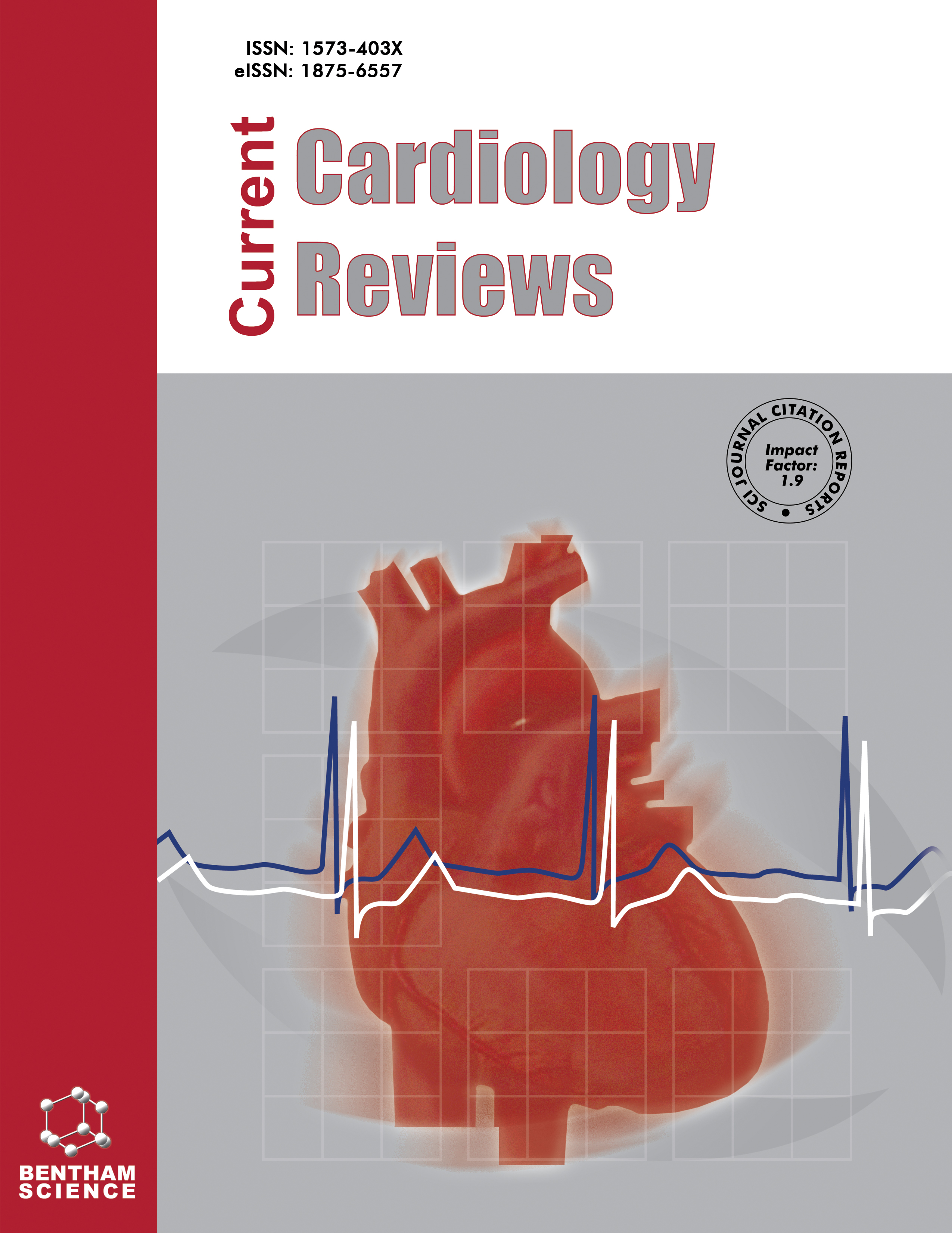- Home
- A-Z Publications
- Current Cardiology Reviews
- Previous Issues
- Volume 18, Issue 5, 2022
Current Cardiology Reviews - Volume 18, Issue 5, 2022
Volume 18, Issue 5, 2022
-
-
Syncope Prediction Scores in the Emergency Department
More LessAuthors: Yan Liang, Xiulian Li, Gary Tse, Emma King, Leonardo Roever, Guangping Li and Tong LiuSyncope is a common clinical presentation defined as a transient loss of consciousness (TLOC) due to cerebral hypoperfusion, characterized by a rapid onset, short duration, and spontaneous complete recovery. Different clinical decision rules (CDRs) and risk stratification scores have been developed to predict short- and long-term risks for adverse outcomes after syncope. The central theme of these prediction systems is c Read More
-
-
-
Obesity Paradox in Atrial Fibrillation and its Relation with the New Oral Anticoagulants
More LessObesity, a chronic disease established as a global epidemic by the World Health Organization, is considered a risk factor for atrial fibrillation (AF), the most common sustained cardiac arrhythmia, which has high morbidity and mortality. Although both obesity and AF are diseases associated with negative outcomes, studies have shown the presence of an obesity paradox, in which patients with a high body mass index (BMI) and AF Read More
-
-
-
COVID-19 Vaccine-Induced Pro-thrombotic Immune Thrombocytopenia (VIPIT): State of the Art
More LessIn 2020, as the severe acute respiratory syndrome coronavirus type 2 (SARS-CoV-2) pandemic spread rapidly throughout the world, scientists worked relentlessly to develop and test the safety and effectiveness of potential vaccines. Usually, the vaccine development process involves years of investigation and testing prior to gaining approval for use in practice. A pathogenic PF4-dependent syndrome, unrelated to the use of Read More
-
-
-
Does Fluid Administration Based on Fluid Responsiveness Tests such as Passive Leg Raising Improve Outcomes in Sepsis?
More LessAuthors: Kenneth Nugent, Gilbert Berdine and Camilo PenaThe management of sepsis requires the rapid administration of fluid to support blood pressure and tissue perfusion. Guidelines suggest that patients should receive 30 ml per kg of fluid over the first one to three hours of management. The next concern is to determine which patients need additional fluid. This introduces the concept of fluid responsiveness, defined by an increase in cardiac output following the administ Read More
-
-
-
Potential Role of Exercise in Regulating YAP and TAZ During Cardiomyocytes Aging
More LessAdaptation of cardiac muscle to regular exercise results in morphological and structural changes known as physiological cardiac hypertrophy, to which the Hippo signaling pathway might have contributed. Two major terminal effectors in the Hippo signaling pathway are Yes-associated protein (YAP) and its homolog transcriptional coactivator with PDZ-binding motif (TAZ). The latest studies have reported the role of YAP and TAZ Read More
-
-
-
Pharmacology Management in Improving Exercise Capacity of Patients with Fontan Circulation: A Systematic Review and Meta-analysis
More LessAuthors: Brian Mendel, Christianto, Moira Setiawan, Sisca N. Siagian and Radityo PrakosoBackground: The Fontan procedure is currently the mainstay therapy for single functional ventricles. However, with prolonged follow-up duration, various complications have been observed that seriously influence the quality of life of patients. Objectives: The aim of this meta-analysis is to compare the effectiveness of pharmacologic agents in improving exercise capacity in patients with Fontan circulation. Methods: This me Read More
-
-
-
Idiopathic Pulmonary Artery Aneurysm: A Case Report
More LessAuthors: Amir M. Salehi and Nakisa KhansariBackground: Idiopathic pulmonary artery aneurysm is a rare disorder that has been reported in less than 50 cases. This complication is often asymptomatic, while the first manifestation can be severe hemoptysis or death. Case Presentation: A 36-year-old man presented to our institute with hemoptysis and fever. Dilated pulmonary artery trunk (5.5 cm) and the left pulmonary artery branch (6.90 cm) were discovered du Read More
-
-
-
Synopsis of Biomarkers of Atheromatous Plaque Formation, Rupture and Thrombosis in the Diagnosis of Acute Coronary Syndromes
More LessAuthors: Ralapanawa Udaya and Ramiah SivakanesanAcute coronary syndrome is the main cause of mortality and morbidity worldwide and early diagnosis is a challenge for clinicians. Though cardiac Troponin, the most commonly used biomarker, is the gold standard for myocardial necrosis, it is blind for ischemia without necrosis. Therefore, ideal biomarkers are essential in the care of patients presenting with symptoms suggestive of cardiac ischemia. The ideal biomarker or Read More
-
-
-
Reperfusion Cardiac Injury: Receptors and the Signaling Mechanisms
More LessIt has been documented that Ca2+ overload and increased production of reactive oxygen species play a significant role in reperfusion injury (RI) of cardiomyocytes. Ischemia/reperfusion induces cell death as a result of necrosis, necroptosis, apoptosis, and possibly autophagy, pyroptosis and ferroptosis. It has also been demonstrated that the NLRP3 inflammasome is involved in RI of the heart. An increase in adrenergic syste Read More
-
-
-
Preeclampsia and Fetal Congenital Heart Defects
More LessAuthors: Bárbara D. Ferreira, Tânia Barros, Maria L. Moleiro and Luís Guedes-MartinsEndothelial dysfunction, impaired implantation and placental insufficiency have been identified as mechanisms behind the development of pre-eclampsia, resulting in angiogenic factors’ alteration. Angiogenic imbalance is also associated with congenital heart defects, and this common physiologic pathway may explain the association between them and pre-eclampsia. This review aims to understand the physiology share Read More
-
Volumes & issues
-
Volume 21 (2025)
-
Volume 20 (2024)
-
Volume 19 (2023)
-
Volume 18 (2022)
-
Volume 17 (2021)
-
Volume 16 (2020)
-
Volume 15 (2019)
-
Volume 14 (2018)
-
Volume 13 (2017)
-
Volume 12 (2016)
-
Volume 11 (2015)
-
Volume 10 (2014)
-
Volume 9 (2013)
-
Volume 8 (2012)
-
Volume 7 (2011)
-
Volume 6 (2010)
-
Volume 5 (2009)
-
Volume 4 (2008)
-
Volume 3 (2007)
-
Volume 2 (2006)
-
Volume 1 (2005)
Most Read This Month
Article
content/journals/ccr
Journal
10
5
false
en


